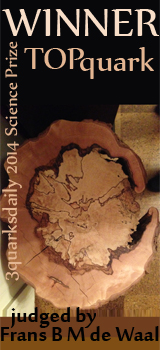


Frans de Waal has picked the three winners from the nine finalists:
- Top Quark, $500: Eric Michael Johnson, Promiscuity Is Pragmatic
- Strange Quark, $200: Christie Wilcox, Did Allergies Evolve To Save Your Life?
- Charm Quark, $100: Carl Zimmer, The Wisdom of (Little) Crowds
Here is what Frans had to say about them:
Eric Michael Johnson knows how to grab the reader’s attention, and does so in “Promiscuity is pragmatic.” In Biology 101, we all have learned that females are the picky sex, and that males roam the field. This view is made to sound logical, and moreover comfortably fits accepted gender roles. Explaining what kind of resistance there has been, and there still is, to violations of this Victorian scenario, Johnson – who is getting a PhD in science history – delves into its history. He portrays anthropology as dominated by white male morality, hence its hostility to theories explaining female “promiscuity” (the term alone is morally loaded!). And not just hostility to the theories: data in support of a more complex view of sexuality are quickly dismissed or simply ignored.
The reason I give this essay top ranking is partly since it is so compellingly written, capable of keeping our attention, but also because the topic is provocative, as attested by the 500+ comments it has elicited. Johnson’s blend of history, primatology, and anthropology works very well in convincing us to pay heed to evolutionary explanations of human behavior. His take is not nearly as narrow as the one common in evolutionary psychology, partly because of his ability and desire to look beyond our own species. He is also not shy to explore science that is at the fringes. Here I don’t mean science at the fringes for being obscure or questionable, but rather because it is subversive.
Johnson has a heretical streak, which makes him pay attention to serious scientists with unconventional ideas. As a result, his writing is more exciting than that of those so seeking to present all sides of an issue as to end up somewhere in the middle. Also, even though Johnson starts out with a primate story, his essay is relevant to all of animal and human science, as attesetd by the ground breaking study on fruit flies that challenged the Bateman hypothesis and the implications for human anthropology.
I found all of the entries very much worth reading, and so it was not easy to pick the two other two Quark Prizes. My second choice is Christie Wilcox’s piece on the toxin hypothesis of allergies. It is well written and the recent mouse work she describes supports the view that allergies reflect a protective mechanism.
My third choice is Carl Zimmer’s essay about small crowds being superior in decision-making compared to big crowds. This essay, too, is a pleasure to read, and systematically explores the idea why crowds make better decisions than single individuals, and why this advantage is not necessarily a linear function of crowd size.
In fact, all three essays explore unusual ideas that seem to go against the mainstream, which makes for exciting reading, leaving one to wonder what other established ideas we may have wrong. As such, these authors promote the healthy skepticism that is the bedrock of science, and show that science is always in flux, always keeping us at the edge of our seat. In a society that sometimes turns away from science, or views it as a boring mass of facts, this is a most important message to convey.
Congratulations also from 3QD to the winners (remember, you must claim the money within one month from today–just send me an email). And feel free, in fact we encourage you, to leave your acceptance speech as a comment here! And thanks to everyone who participated. Many thanks also, of course, to Frans de Waal for doing the final judging.
The three prize logos at the top of this post were designed by Sughra Raza, me, and Carla Goller. I hope the winners will display them with pride on their own blogs!
Details about the prize here.
Siddhartha Deb at The Nation:
